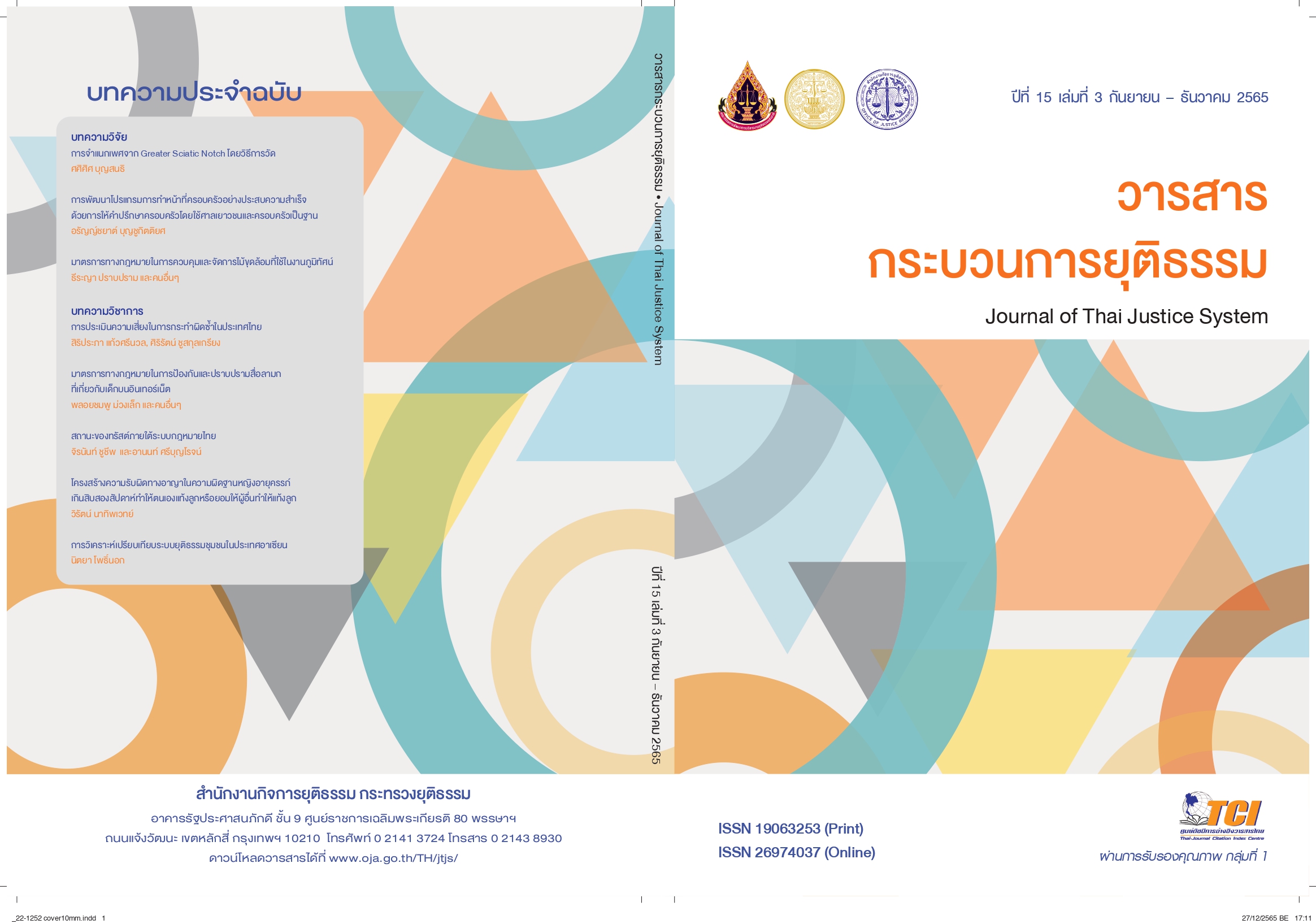การพัฒนาโปรแกรมการทำหน้าที่ครอบครัวอย่างประสบความสำเร็จ ด้วยการให้คำปรึกษาครอบครัวโดยใช้ศาลเยาวชนและครอบครัวเป็นฐาน
Main Article Content
บทคัดย่อ
การวิจัยครั้งนี้มีความมุ่งหมาย (1) เพื่อพัฒนาโปรแกรมการทำหน้าที่ครอบครัวอย่างประสบความสำเร็จด้วยการให้คำปรึกษาครอบครัวโดยใช้ศาลเยาวชนและครอบครัวเป็นฐาน (2) เพื่อศึกษาผลของการพัฒนาโปรแกรมการทำหน้าที่ครอบครัวอย่างประสบความสำเร็จด้วยการให้คำปรึกษาครอบครัวโดยใช้ศาลเยาวชนและครอบครัวเป็นฐาน และ (3) เพื่อเปรียบเทียบการทำหน้าที่ครอบครัวก่อนการให้คำปรึกษาและภายหลังการให้คำปรึกษา กลุ่มตัวอย่างในการวิจัยครั้งนี้ เป็นครอบครัวของเด็กและเยาวชนที่เข้าสู่กระบวนการศาลเยาวชนและครอบครัวจังหวัดราชบุรี จำนวน 10 ครอบครัว จำนวน 30 คน จากนั้นสุ่มอย่างง่าย (simple random sampling) แบ่งเป็นกลุ่มทดลองจำนวน 5 ครอบครัว เพื่อเข้ารับการให้คำปรึกษาครอบครัวด้วยโปรแกรมการทำหน้าที่ครอบครัวอย่างประสบความสำเร็จด้วยการให้คำปรึกษาครอบครัวโดยใช้ศาลเยาวชนและครอบครัวเป็นฐาน และกลุ่มควบคุมจำนวน 5 ครอบครัว ไม่ได้รับการให้คำปรึกษา
ผลการศึกษาวิจัยสรุปได้ดังนี้
1. โปรแกรมการให้คำปรึกษาครอบครัวอย่างประสบความสำเร็จโดยใช้ศาลเยาวชนและครอบครัวเป็นฐานของกลุ่มทดลองก่อนเข้ารับการให้คำปรึกษาและหลังเข้ารับโปรแกรมการให้คำปรึกษาครอบครัวอย่างประสบความสำเร็จโดยใช้ศาลเยาวชนและครอบครัวเป็นฐานมีความแตกต่างกันอย่างมีนัยสำคัญทางสถิติที่ระดับ .001
2. การทำหน้าที่ของครอบครัวในด้านต่าง ๆ ประกอบด้วย ด้านการแก้ปัญหา ด้านการสื่อสาร ด้านบทบาทของครอบครัว ด้านการตอบสนองทางอารมณ์ ด้านความผูกพันทางอารมณ์ ด้านการควบคุมพฤติกรรม ด้านการทำหน้าที่ทั่วไป ของกลุ่มทดลองก่อนเข้ารับโปรแกรมการให้คำปรึกษาครอบครัวอย่างประสบความสำเร็จโดยใช้ ศาลเยาวชนและครอบครัวเป็นฐานและหลังเข้ารับโปรแกรมการให้คำปรึกษาครอบครัวอย่างประสบความสำเร็จ โดยใช้ศาลเยาวชนและครอบครัวเป็นฐานทุกองค์ประกอบมีความแตกต่างกันอย่างมีนัยสำคัญทางสถิติที่ระดับ .001
3. การให้คำปรึกษาครอบครัวของกลุ่มควบคุมก่อนเข้ารับการให้คำปรึกษาและหลังเข้ารับการ ให้คำปรึกษาไม่แตกต่างกันอย่างมีนัยสำคัญทางสถิติที่ระดับ .05
ข้อเสนอแนะ
1. แบบวัดการทำหน้าที่ครอบครัวสามารถนำไปใช้ได้กับครอบครัวทั่วไป เพื่อเป็นเครื่องมือในการวัดการทำหน้าที่ครอบครัวสามารถทำให้ทราบถึงระดับของการทำหน้าที่ครอบครัวของสมาชิกภายในครอบครัวแต่ละคนได้ แต่อย่างไรก็ตามก่อนนำแบบวัดการทำหน้าที่ครอบครัวไปใช้ต้องมีการศึกษารายละเอียดและวิธีการให้คะแนนของแบบวัดให้ชัดเจนก่อน
2. การนำโปรแกรมการทำหน้าที่ครอบครัวอย่างประสบความสำเร็จด้วยการให้คำปรึกษาครอบครัวโดยใช้ศาลเยาวชนและครอบครัวเป็นฐานไปใช้ควรศึกษาและทำความเข้าใจเกี่ยวกับรายละเอียดของแนวคิดสำคัญขั้นตอนและเทคนิคการให้คำปรึกษาในโปรแกรมฯ และผู้ให้คำปรึกษาควรได้รับการฝึกการให้คำปรึกษาครอบครัวและได้รับการฝึกการทำงานในระบบการปฏิบัติงานภายในศาลเยาวชนและครอบครัวมาเป็นอย่างดีแล้วจึงจะสามารถดำเนินการให้คำปรึกษาตามโปรแกรมการทำหน้าที่ครอบครัวอย่างประสบความสำเร็จด้วยการ ให้คำปรึกษาครอบครัวโดยใช้ศาลเยาวชนและครอบครัวเป็นฐานเพื่อพัฒนาเด็ก เยาวชนและครอบครัวในการทำหน้าที่ครอบครัวอย่างประสบความสำเร็จและไม่หวนกลับมากระทำความผิดซ้ำได้
Article Details

อนุญาตภายใต้เงื่อนไข Creative Commons Attribution-NonCommercial-NoDerivatives 4.0 International License.
ต้นฉบับที่ได้รับการตีพิมพ์ในวารสาร เป็นลิขสิทธิ์ของวารสารกระบวนการยุติธรรม แต่ความคิดเห็นที่ปรากฏในเนื้อหาของบทความในวารสารกระบวนการยุติธรรม ถือเป็นความรับผิดชอบของผู้เขียนแต่เพียงผู้เดียว
เอกสารอ้างอิง
กรรณิการ์ นลราชสุวัจน์. (2551). ทฤษฎีและแนวปฏิบัติในการให้คำปรึกษา (หน่วยที่ 9-15) (พิมพ์ครั้งที่ 3). นนทบุรี: สำนักพิมพ์มหาวิทยาลัยสุโขทัยธรรมาธิราช.
ผ่องพรรณ เกิดพิทักษ์. (2529). การแนะแนวและการให้คำปรึกษาในโรงเรียนประถมศึกษา. กรุงเทพฯ: บัณฑิตการพิมพ์.
ราชบัณฑิตยสถาน. (2525). พจนานุกรม ฉบับราชบัณฑิตยสถาน พ.ศ. 2525 (ฉบับพิมพ์ครั้งที่ 5). กรุงเทพฯ: อักษรเจริญทัศน์.
อุมาพร ตรังคสมบัติ. (2544). จิตบำบัดและการให้คำปรึกษาครอบครัว (พิมพ์ครั้งที่ 5). กรุงเทพฯ: ศูนย์วิจัยและพัฒนาครอบครัว.
Beavers, R., & Hampson, R. B. (2000). The beavers systems model of family functioning. Journal of Family Therapy, 22(2), 128-143.
Bowen, M. (1993). Family therapy in clinical practice. NJ: Jason Aronson.
Carlson, J., Sperry, L., & Lewis, J. A. (1997). Family therapy: Ensuring treatment efficacy. CA: Thomson Brooks/Cole Publishing.
Colman, A. M. (2003). Cooperation, psychological game theory, and limitations of rationality in social interaction. Behavioral and brain sciences, 26(2), 139-153.
De Shazer, S., Dolan, Y., Korman, H., McCollum, E. T. T., & Berg, IK (2007). More than miracles: The state of the art of solution-focused brief therapy. NY: Haworth press.
Goldenberg, I. & Goldenberg, H. (2004). Family therapy an overview (6th ed.). U.S.A.: Brooks & Cole.
Miller, I. W., Epstein, N. B., Bishop, D. S., & Keitner, G. I. (1985). The McMaster family assessment device: reliability and validity. Journal of
Marital and Family Therapy, 11(4), 345-356.
Minuchin, S. (2018). Families and familytherapy. London: Routledge.
Sadock, B. J. (1998).Study guide and self-examination review for Kaplan and Sadock's synopsis of psychiatry. Maryland: Williams & Wilkins.
Satir, V., & Baldwin, M. (1988). Familientherapie in Aktion: die Konzepte von Virginia Satir in Theorie und Praxis. Germany: Junfermann Verlag GmbH.
Skinner, H., Steinhauer, P., &Sitarenios, G. (2000). Family Assessment Measure (FAM) and process model of family functioning. Journal of Family Therapy, 22(2), 190-210.
White, M., White, M. K., Wijaya, M., & Epston, D. (1990). Narrative means to therapeuticends. New york: WW Norton & Company.


